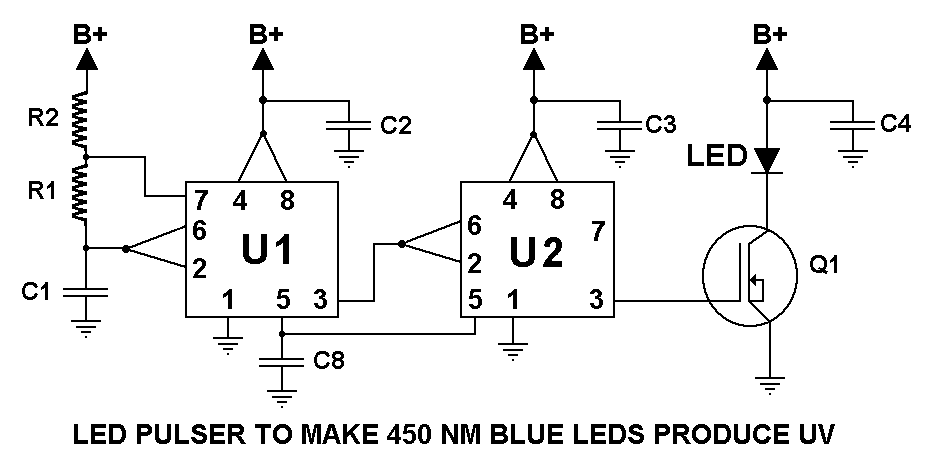
Nichia UV LEDs
UV LEDs by others
Forcing certain blue LEDs to produce UV
This was as of early 2001, and they have probably improved slightly since.
These have some broadband visible output and ones that I have seen glow a dim violetish white color. You may want to filter them if you are using them as blacklights.
Nichia imposes paperwork requirements on purchasers. Purchasers must sign paperwork agreeing to heed warnings about eye hazards of the UV, pass on warnings of the eye hazards of the UV, release Nichia from liability for UV eye hazards, and also to not reverse-engineer the UV LEDs, and not even do failure/defect analysis on bad UV LEDs without Nichia permission (I suspect Nichia fears that could yield reverse engineering data).
If you can get your hands on any of these (probably largely considered obsolete) 450 nM broadband blue LEDs, you can hack them into a true UV LED blacklight. Don't expect nearly as much UV as you would from a Nichia NSHU590, but enough to get a bit of a blacklight.
NOT AS SUITABLE:
* 428-430 nM LEDs such as Radio Shack 276-311
* Any with only one connection to the top surface of the die - at its
center, even if the wavelength is right.
* Any known to have dice made by Cree, Agilent, or ISP.
* All with SiC whether with or without GaN, even if the wavelength is right
* InGaN / narrowband models, even if the wavelength is right
* Ones with rated voltage over 4 volts
* All with peak wavelength 460 nm or longer
* Most with dominant wavelength around 470 nm
* Just about all blues of 2000 mcd or more
* Probably all models with color ranking or color/wavelength bin sorting
* Nichia's NS****** models (what they make now)
* Everlight models in general.
* SQW (single quantum well) models.
* Most, probably all bright LEDs from LED flashlights, keychain size or
larger.
Now if you have the right blue LED, here is how to make it produce UV:
The key is high instantaneous current. Most LEDs involving gallium nitride as well as a few others (notably gallium phosphide low current red) have spectral characteristics significantly varying with current.
(non-red GaP, InGaAlP, GaAlP, GaAs, GaAlAs, GaAlAsP, GaAsP, and most non-GaP red have little to zero or even slightly negative shortward spectral shift at higher currents!)
The broadband 450 nM blue GaN LED, at higher currents near or over half an amp, develops a secondary spectral feature - a band around 385-390 nM in the very near UV! This band somewhat merges into the main broad visible band and is not always plain-as-day distinct but it is there when these LEDs are fed with really high currents around an amp. This may be a "superluminescent" effect, which involves stimulated emission but not the coherent oscillation of a laser.
Of course, the LED will not survive such current for long. But it can (at least usually) survive such current for 1 microsecond a few times a millisecond.
What I did that worked:
1 microsecond on, repeated every 200 microseconds (5 KHz).
With a 14 volt supply and a 5 ohm series resistor, the current was measured at .6 amp. This means about 11 volts across the LED. I shorted the resistor and extrapolate the current to .9 amp and the LED still worked!
UPDATE 5/8/2001 - Here is a schematic!
Supply voltage - 12 volts, 14 or maybe 15 if you dare!
C1 - 1500 pF or 1470 pF
C2, C3 - .1 uF ceramic
C8 - UPDATE 10/1/2006 - .001 uF ceramic. I changed this from .1 uF because
I was concerned about the pulse rate being excessive until this capacitor
charges up. However, I am not aware of any actual LED blowouts from C8
having a higher value up to .1 uF.
C4 - 10 uF 16 to 35V electrolytic or tantalum
Q1 - IRF510 or IRF511, Radio Shack 276-2072 or other power MOSFET with
resistance 1 ohm or less and input capacitance no higher than that of IRF510.
R1 - 1.0K
R2 - 220K
U1, U2 - LMC555 or TLC555, Radio Shack 276-1718
I tried filtering the LED with a piece of tubing hacked from a fluorescent type blacklight and got an LED blacklight. This made white cotton clothes fluoresce blue, which indicates UV. (Most fluorescent organic compounds that are green, yellow, orange, red, pink or magenta and glow colors from green to red will fluoresce from some visible wavelengths as well as UV.)
For more on hacking blacklight fluorescent lamps, Go Here!
UPDATE 10/1/2006 - links updated 6/15/2022 - Craig Johnson showed a spectral power distribution curve of this being done to a Nichia NLPB series blue LED and a Panasonic LED with a chip that is the same as or similar to that used in Nichia NLPB series LEDs among many other LED spectra at (via the Wayback Machine) http://ledmuseum.home.att.net/specx22.htm
Spectral power distribution curves of these broadband blue LEDs being operated normally are in a separate page at (via the Wayback Machine) http://ledmuseum.home.att.net/led1/specx21.htm
My thanks to Craig Johnson for bringing this effect of high current pulsing of broadband 450 nM GaN LEDs to my attention!
Please read my Copyright and authorship info.
Please read my Disclaimer.